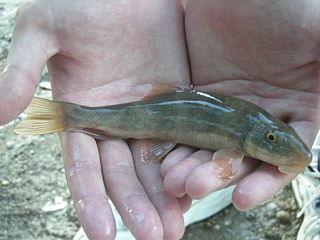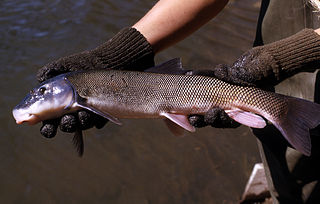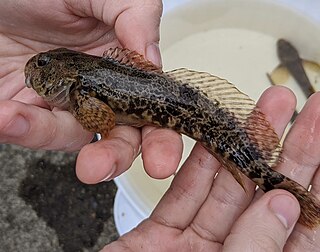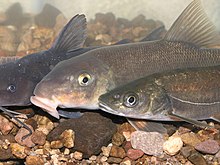
The Virgin River is a tributary of the Colorado River in the U.S. states of Utah, Nevada, and Arizona. The river is about 162 miles (261 km) long. It was designated Utah's first wild and scenic river in 2009, during the centennial celebration of Zion National Park.

The longnose sucker is a species of cypriniform freshwater fish in the family Catostomidae. It is native to North America from the northern United States to the top of the continent. It is also found in Russia in rivers of eastern Siberia, and this one of only two species of sucker native to Asia.

Catostomus is a genus of fish belonging to the family Catostomidae, commonly known as suckers. This genus of fish usually lives in freshwater basins. Most members of the genus are native to North America, but C. catostomus is also found in Russia.

The mountain sucker is a sucker found throughout western North America, on both sides of the Rocky Mountains, including the upper Missouri River, Columbia River, Sacramento River, and Colorado River. It is not limited to higher altitudes but is known from locations as high as 2,800 m (9,200 ft). It is a slender, streamlined fish typically under 20 cm (8 in) in length. It is generally olive green or brown above, with pale underparts, and breeding males have a lateral red-orange band and fins suffused with the same color. It is mainly herbivorous, feeding on algae and diatoms. Breeding takes place in late spring and early summer in gravelly riffles in small streams.

The golden redhorse is a species of freshwater fish endemic to Ontario and Manitoba in Canada and the Midwestern, southern, and eastern United States. It lives in calm, often silty or sandy waters in streams, small to large rivers, and lakes.

The silver redhorse is a species of freshwater fish endemic to Canada and the United States. It is the longest-lived redhorse known, with a maximum reported age of 41 years. Sometimes called redhorse or sucker for short, it is in the family Catostomidae with other suckers. The species is distributed from Quebec to Alberta and is also in the Mississippi River, St. Lawrence River, Ohio River, and the Great Lakes basins. The current world record is 14 pounds, 14 ounces, caught by Chris Stephenson on Pickwick Lake in Alabama, April 1995 and certified by National Freshwater Fishing Hall of Fame. This species is of growing interest to rod-and-line anglers. The long-lived and late-maturing silver redhorse is also a sportfish pursued by kill-and-dump bowfishing, a 21st century unregulated sport that produces tons of wanton waste, and thus management and conservation are in need of updating.

The Utah sucker is a species of freshwater fish in the family Catostomidae found in the upper Snake River and the Lake Bonneville areas of western North America where it lives in a wide range of habitats. It is a large sucker growing up to 25 in (64 cm) long. It is generally blackish above, vaguely streaked and blotched, with a white belly. A narrow rosy lateral band extends backwards from the head. The mouth has thick lips and is on the underside of the head. Some populations are in decline because of anthropogenic factors but overall this fish is not threatened.

The bonytail chub or bonytail is a cyprinid freshwater fish native to the Colorado River basin of Arizona, California, Colorado, Nevada, New Mexico, Utah and Wyoming in the southwestern United States; it has been extirpated from the part of the basin in Mexico. It was once abundant and widespread in the basin, its numbers and range have declined to the point where it has been listed as endangered since 1980 (ESA) and 1986 (IUCN), a fate shared by the other large Colorado basin endemic fish species like the Colorado pikeminnow, humpback chub, and razorback sucker. It is now the rarest of the endemic big-river fishes of the Colorado River. There are 20 species in the genus Gila, seven of which are found in Arizona.

The Yaqui sucker is a species of ray-finned fish in the family Catostomidae. It is found the Aridoamerica region of northern Mexico and south-western United States. Catostomus bernardini or Yaqui sucker belongs to the family Catostomidae. The Yaqui sucker is related to the Sonora sucker and could possibly be a subspecies of the Gila sucker.

The Catostomidae are the suckers of the order Cypriniformes, with about 78 species in this family of freshwater fishes. The Catostomidae are almost exclusively native to North America. The only exceptions are Catostomus catostomus, found in both North America and Russia, and Myxocyprinus asiaticus found only in China. In the Ozarks they are a common food fish and a festival is held each year to celebrate them. The bigmouth buffalo, Ictiobus cyprinellus, can reach an age up to 127 years, making it the oldest known freshwater teleost by more than 50 years.

The bluehead sucker is endemic to the intermountain Western US. A total of 23 members of the genus Catostomus has been found in North America. C. discobolus and C. yarrowi are two sister species that have very similar Arizona habitats.

Catostomus latipinnis is a North American fish identified by its enlarged lower lips. It belongs to the genus Catostomus, commonly known as suckers. Historically, the flannelmouth sucker ranged in the Colorado River Basin, including parts of Wyoming, Utah, Colorado, New Mexico, Nevada, California, and Arizona; however, this species has been entirely extirpated from the Gila River Basin in Arizona.
The Little Colorado River sucker or Little Colorado sucker is a scientifically undescribed species of North American freshwater fish very similar to the flannelmouth sucker but without the flannelmouth's distinct fleshy lips. The Little Colorado sucker is native to the upper region of the Little Colorado River in Arizona, but was also introduced into the Salt River.
Catostomus discobolus jarrovii is a species of fish only found in Arizona and New Mexico in the United States.
The plains minnow is one of the 324 fish species found in central United States. It is a large minnow that was once a common bait fish. The plains minnow requires shallow, slow-moving streams to complete its life cycle. Pollution, dams, and introduced sport fish have caused populations to decline.

The prickly sculpin is a species of ray-finned fish belonging to the family Cottidae, the typical sculpins. It is native to the river drainages of the Pacific Slope of North America from Seward, Alaska south to the Ventura River of Southern California. It extends east of the Continental Divide in the Peace River of British Columbia. It has also been introduced to several reservoirs in Southern California.

The desert sucker or Gila Mountain sucker, is a freshwater species of ray-finned fish in the sucker family, endemic to the Great Basin and the Colorado River Basin in the United States. It inhabits rapids and fast-flowing streams with gravelly bottoms. It is a bi-colored fish with the upper parts olive brown to dark green, and the underparts silvery-tan or yellowish. The head is cylindrical, tapering to a thick-lipped mouth on the underside. This fish can grow to 31 in (79 cm) in Arizona but is generally only about half this size elsewhere. There are three subspecies, found in different river basins, and some authorities allot this species its own genus Pantosteus.

The white sucker is a species of freshwater cypriniform fish inhabiting the upper Midwest and Northeast in North America, but it is also found as far south as Georgia and as far west as New Mexico. The fish is commonly known as a "sucker" due to its fleshy, papillose lips that suck up organic matter and aufwuchs from the bottom of rivers and streams.

The Tahoe sucker is a freshwater cypriniform fish inhabiting the Great Basin region of the Western United States.

The Rio Grande chub is a cyprinid fish endemic to the United States. It inhabits the upper Rio Grande and Pecos River systems in Colorado, New Mexico and Texas. The Rio Grande chub is native to most of its current range including all three of the states it can be found in. There are non-native populations that currently inhabit Coyote Creek, the Mora River, the Sapello River and other areas in New Mexico. There are currently no studies showing how the Rio Grande chub is impacting waterways in its non-native range. It has also been proposed that this fish is native to the Canadian River in New Mexico but this has not been proven. It is possible it was introduced there. Natural hybridization can occur between the Rio Grande chub and the longnose dace.



















